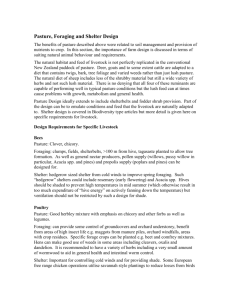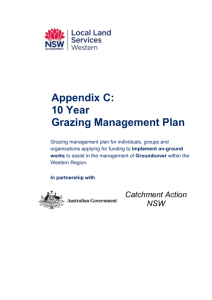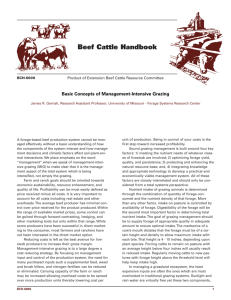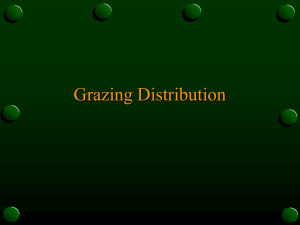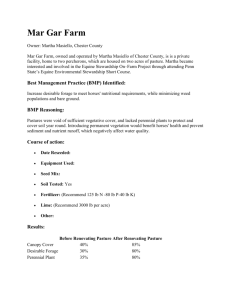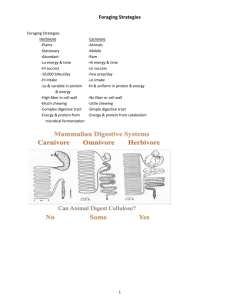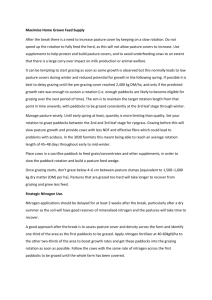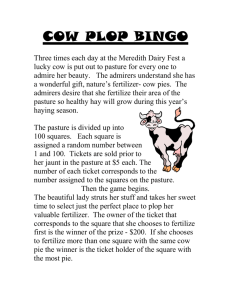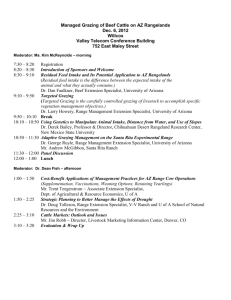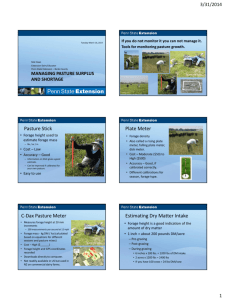Dry Matter Intake (DMI) Worksheet
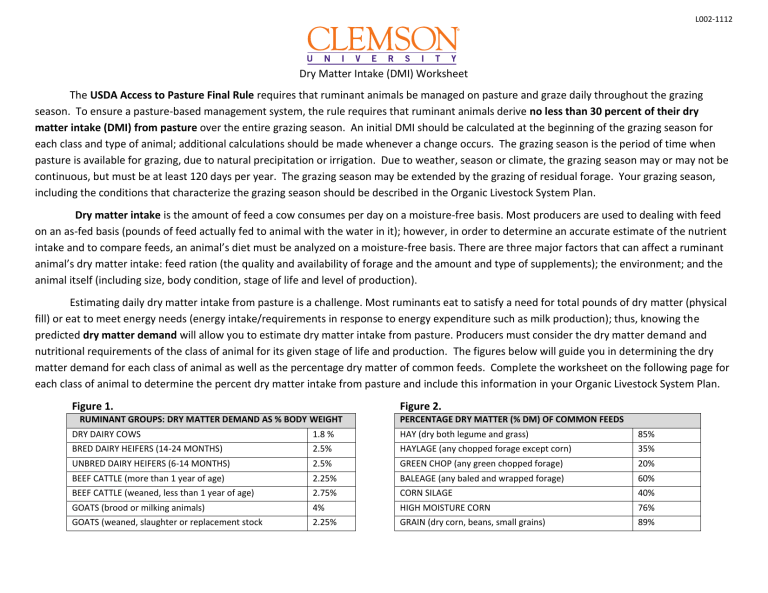
L002-1112
Dry Matter Intake (DMI) Worksheet
The USDA Access to Pasture Final Rule requires that ruminant animals be managed on pasture and graze daily throughout the grazing season. To ensure a pasture-based management system, the rule requires that ruminant animals derive no less than 30 percent of their dry
matter intake (DMI) from pasture over the entire grazing season. An initial DMI should be calculated at the beginning of the grazing season for each class and type of animal; additional calculations should be made whenever a change occurs. The grazing season is the period of time when pasture is available for grazing, due to natural precipitation or irrigation. Due to weather, season or climate, the grazing season may or may not be continuous, but must be at least 120 days per year. The grazing season may be extended by the grazing of residual forage. Your grazing season, including the conditions that characterize the grazing season should be described in the Organic Livestock System Plan.
Dry matter intake is the amount of feed a cow consumes per day on a moisture-free basis. Most producers are used to dealing with feed on an as-fed basis (pounds of feed actually fed to animal with the water in it); however, in order to determine an accurate estimate of the nutrient intake and to compare feeds, an animal’s diet must be analyzed on a moisture-free basis. There are three major factors that can affect a ruminant animal’s dry matter intake: feed ration (the quality and availability of forage and the amount and type of supplements); the environment; and the animal itself (including size, body condition, stage of life and level of production).
Estimating daily dry matter intake from pasture is a challenge. Most ruminants eat to satisfy a need for total pounds of dry matter (physical fill) or eat to meet energy needs (energy intake/requirements in response to energy expenditure such as milk production); thus, knowing the predicted dry matter demand will allow you to estimate dry matter intake from pasture. Producers must consider the dry matter demand and nutritional requirements of the class of animal for its given stage of life and production. The figures below will guide you in determining the dry matter demand for each class of animal as well as the percentage dry matter of common feeds. Complete the worksheet on the following page for each class of animal to determine the percent dry matter intake from pasture and include this information in your Organic Livestock System Plan.
Figure 1.
RUMINANT GROUPS: DRY MATTER DEMAND AS % BODY WEIGHT
DRY DAIRY COWS 1.8 %
BRED DAIRY HEIFERS (14-24 MONTHS) 2.5%
UNBRED DAIRY HEIFERS (6-14 MONTHS) 2.5%
BEEF CATTLE (more than 1 year of age) 2.25%
BEEF CATTLE (weaned, less than 1 year of age) 2.75%
GOATS (brood or milking animals) 4%
GOATS (weaned, slaughter or replacement stock 2.25%
Figure 2.
PERCENTAGE DRY MATTER (% DM) OF COMMON FEEDS
HAY (dry both legume and grass)
HAYLAGE (any chopped forage except corn)
GREEN CHOP (any green chopped forage)
BALEAGE (any baled and wrapped forage)
CORN SILAGE
HIGH MOISTURE CORN
GRAIN (dry corn, beans, small grains)
85%
35%
20%
60%
40%
76%
89%
L002-1112
Dry Matter Intake (DMI) Worksheet
Producers of organic ruminant livestock are required per §205.240 to provide a full description of feed rations and calculations to demonstrate compliance with
§205.237(c)(2). You may use this form to calculate dry matter intake from pasture and to document changes in rations throughout the year. Use Figure 1 and
Figure 2 from the previous page in your calculations below. Complete a new form when rations change.
Applicant/company name:
Species/Breed of animal:
Date: Group/Ration Name:
Number of animals in this group:
A. Dry Matter Demand (DMD):
Average Weight per Animal
X
B. WINTER (NON-GRAZING) RATION
% DM X AVERAGE LBS OF FEED = DRY MATTER FED
LIST ALL FEED TYPES: % DM OF FEED
See Fig. 2
AVERAGE LBS FEED
PER HD
EXAMPLE: GRAIN 89% (.89) X 10 # =
X
X
X
=
=
=
X
X
=
=
X
X
TOTAL DM FED
D. PASTURE CALCULATION
DMD (from A) minus Total DM Fed (from C) =
=
=
- =
DM FED
Pasture DM
Fed
8.9#
DMD as % of Body Weight
See Fig. 1 on Previous Page
Dry Matter Demand
=
C. SUMMER (GRAZING) RATION
% DM X AVERAGE LBS OF FEED = DRY MATTER FED
LIST ALL FEED TYPES: % DM OF FEED
See Fig. 2
AVERAGE LBS FEED
PER HD
EXAMPLE: GRAIN 89% (.89) X 10 # =
X
X
X
X
X
X
X
=
=
=
=
=
=
=
TOTAL DM FED divided by
÷
DMD (from A) =
= X 100 =
DM FED
8.9#
DMI Percent from pasture
%

